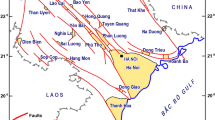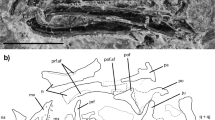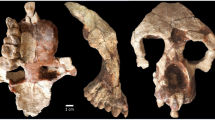Abstract
Morphological, molecular, and biogeographic data bearing on early primate evolution suggest that the clade containing extant (or ‘crown’) strepsirrhine primates (lemurs, lorises and galagos) arose in Afro-Arabia during the early Palaeogene1, but over a century of palaeontological exploration on that landmass has failed to uncover any conclusive support for that hypothesis2. Here we describe the first demonstrable crown strepsirrhines from the Afro-Arabian Palaeogene—a galagid and a possible lorisid from the late middle Eocene of Egypt, the latter of which provides the earliest fossil evidence for the distinctive strepsirrhine toothcomb. These discoveries approximately double the previous temporal range of undoubted lorisiforms and lend the first strong palaeontological support to the hypothesis of an ancient Afro-Arabian origin for crown Strepsirrhini and an Eocene divergence of extant lorisiform families1,3.
This is a preview of subscription content, access via your institution
Access options
Subscribe to this journal
Receive 51 print issues and online access
$199.00 per year
only $3.90 per issue
Buy this article
- Purchase on SpringerLink
- Instant access to full article PDF
Prices may be subject to local taxes which are calculated during checkout



Similar content being viewed by others
References
Yoder, A. D., Cartmill, M., Ruvolo, M., Smith, K. & Vilgalys, R. Ancient single origin for Malagasy primates. Proc. Natl Acad. Sci. USA 93, 5122–5126 (1996)
Simons, E. L. Discovery of the smallest Fayum Egyptian primates (Anchomomyini, Adapidae). Proc. Natl Acad. Sci. USA 94, 180–184 (1997)
Yoder, A. D. Back to the future: A synthesis of strepsirrhine systematics. Evol. Anthropol. 6, 11–22 (1997)
Charles-Dominique, P. & Martin, R. D. Evolution of lorises and lemurs. Nature 227, 257–260 (1970)
Martin, R. D. Primate Origins and Evolution: A Phylogenetic Reconstruction (Princeton Univ. Press, Princeton, 1990)
Porter, C. A. et al. Phylogeny and evolution of selected primates as determined by sequences of the ɛ-globin locus and 5′ flanking regions. Int. J. Primatol. 18, 261–295 (1997)
Marivaux, L. et al. A fossil lemur from the Oligocene of Pakistan. Science 294, 587–591 (2001)
Martin, R. D. Origins, diversity, and relationships of lemurs. Int. J. Primatol. 21, 1021–1049 (2000)
McCall, R. A. Implications of recent geological investigations of the Mozambique Channel for the mammalian colonization of Madagascar. Proc. R. Soc. Lond. B 264, 663–665 (1997)
Rose, K. D., Godinot, M. & Bown, T. M. in Anthropoid Origins (eds Fleagle, J. G. & Kay, R. F.) 1–28 (Plenum, New York, 1994)
Simpson, G. G. The tertiary lorisiform primates of Africa. Bull. Mus. Comp. Zool. 136, 39–62 (1967)
Phillips, E. M. & Walker, A. in The Primate Fossil Record (ed. Hartwig, W. C.) 83–95 (Cambridge Univ. Press, Cambridge, 2002)
Gingerich, P. D. Marine mammals (Cetacea and Sirenia) from the Eocene of Gebel Mokattam and Fayum, Egypt: Stratigraphy, age, and paleoenvironments. Univ. Mich. Pap. Paleontol. 30, 1–84 (1992)
Beadnell, H. J. L. The Topography and Geology of the Fayum Province of Egypt (Survey Department of Egypt, Cairo, 1905)
Bown, T. M. & Kraus, M. J. Geology and paleoenvironment of the Oligocene Jebel Qatrani Formation and adjacent rocks, Fayum Depression, Egypt. U S Geol. Surv. Prof. Pap. 1452, 1–64 (1988)
Holroyd, P. A., Simons, E. L., Bown, T. M., Polly, P. D. & Kraus, M. J. New records of terrestrial mammals from the upper Eocene Qasr el Sagha Formation, Fayum Depression, Egypt. Palaeovertebrata 25, 175–192 (1996)
Kappelman, J., Simons, E. L. & Swisher, C. C. III New age determinations for the Eocene-Oligocene boundary sediments in the Fayum Depression, northern Egypt. J. Geol. 100, 647–668 (1992)
Simons, E. L., Rasmussen, D. T., Bown, T. M. & Chatrath, P. S. in Anthropoid Origins (eds Fleagle, J. G. & Kay, R. F.) 179–201 (Plenum, New York, 1994)
Conroy, G. C. Problems of body-weight estimation in fossil primates. Int. J. Primatol. 8, 115–137 (1987)
Rose, K. D., Walker, A. C. & Jacobs, L. L. Function of the mandibular tooth comb in living and extinct mammals. Nature 289, 583–585 (1981)
Yoder, A. D., Irwin, J. A. & Payseur, B. A. Failure of the ILD to determine data combinability for slow loris phylogeny. Syst. Biol. 50, 408–424 (2001)
Rasmussen, D. T. & Nekaris, K. A. Evolutionary history of lorisiform primates. Folia Primatol. 69 Suppl. 1, 250–285 (1998)
Simons, E. L., Bown, T. M. & Rasmussen, D. T. Discovery of two additional prosimian primate families (Omomyidae, Lorisidae) in the African Oligocene. J. Hum. Evol. 15, 431–437 (1986)
Godinot, M. in Anthropoid Origins (eds Fleagle, J. G. & Kay, R. F.) 235–295 (Plenum, New York, 1994)
Gheerbrant, E., Thomas, H., Sen, S. & Al-Sulaimani, Z. Nouveau primate Oligopithecinae (Simiiformes) de l'Oligocène inférieur de Taqah, Sultanat d'Oman. CR Acad. Sci. Ser. Ila 321, 425–432 (1995)
MacLatchy, L. & Kityo, R. A lower Miocene lorid femur from Napak, Uganda. Am. J. Phys. Anthropol. 34 Suppl, 104–105 (2002)
Rambaut, A. & Bromham, L. Estimating divergence dates from molecular sequences. Mol. Biol. Evol. 15, 442–448 (1998)
Tavaré, S., Marshall, C. R., Will, O., Soligo, C. & Martin, R. D. Using the fossil record to estimate the age of the last common ancestor of extant primates. Nature 416, 726–729 (2002)
Maier, W. Konstruktionsmorphologische Untersuchungen am Gebiß der rezenten Prosimiae (Primates). Abh. Senckenb. Naturforsch. Ges. 538, 1–158 (1980)
Swofford, D. L. PAUP*, Phylogenetic Analysis Using Parsimony and Other Methods (Sinauer, Sunderland, Massachusetts, 1998)
Acknowledgements
We thank K. Soliman, A. Swedan, A. Hassen, F. Imbabi, and the numerous other scientists from the Egyptian Geological Survey and Mining Authority and the Egyptian Geological Museum who have supported and facilitated our collaborative palaeontological work in northern Egypt. P. Chatrath managed field operations in Egypt. T. M. Bown discovered BQ-2, and together with M. Mathison measured the geological section reported herein. T. M. Bown, P. Chatrath and M. Mathison also helped with collecting during the 2001 season along with A. Abd el-Ghafar, M. Abd el-Ghany, Y. Abd el-Razik, H. Ali, J. Fleagle, G. Kamel, A. Hassen, M. Hassen Taha, C. Heesy, L. Jolly, P. Lewis, G. Mohamed, S. Mohamed, R. Patnaik and M. Zakaria. We thank F. Ankel-Simons, R. Martin, J. Rossie, T. Ryan, C. Simons and A. Yoder for discussion and/or comments on the manuscript. Recent work in Egypt has been generously supported by a National Science Foundation grant to E.L.S. and Leakey Foundation grants to E.R.S.
Author information
Authors and Affiliations
Corresponding author
Ethics declarations
Competing interests
The authors declare that they have no competing financial interests.
Supplementary information
Rights and permissions
About this article
Cite this article
Seiffert, E., Simons, E. & Attia, Y. Fossil evidence for an ancient divergence of lorises and galagos. Nature 422, 421–424 (2003). https://doi.org/10.1038/nature01489
Received:
Accepted:
Issue Date:
DOI: https://doi.org/10.1038/nature01489




